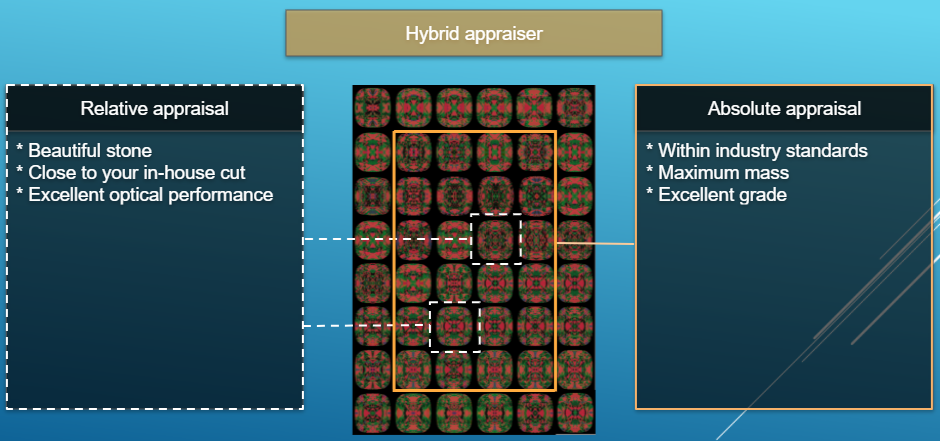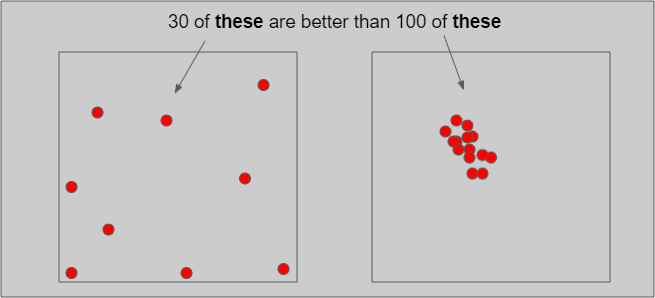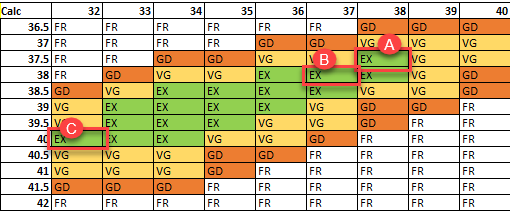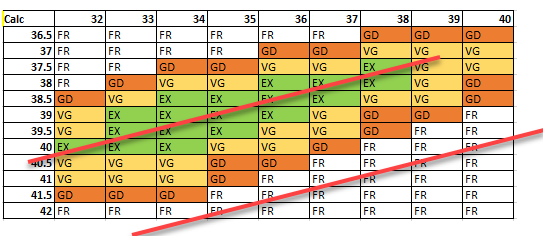Overview
To get plans with the best combination of mass and performance, add your in-house cuts to the system, populate them with forms, then allocate plans close to these forms with a hybrid appraiser.
How?
- Add what you consider beautiful as your in-house cut.
- Add variations of forms.
- Allocate future plans close to your forms by a hybrid appraiser.
A hybrid appraiser has both absolute and relative parts:
- The absolute part will provide a maximum mass without a grade loss (industry-standard intervals).
- The relative part will allocate plans close to your own forms with excellent optical performance.
And thus:
Adding allocation forms to linked cut
As mentioned in the previous section, a hybrid appraiser works great in pair with the linked in-house cut: the relative part of a hybrid appraiser binds the created solutions to the allocation forms of this cut. Therefore, it is important not only to create and configure the appraiser itself but also to add the appropriate allocation forms to the linked cut.
Some questions and answers on allocation forms:
How many and what forms should be added?
You need at least 20-30 forms. It is better to have more*. The quantity depends on the quality:
In a multidimensional array of diamond parameters**, the more these parameters differ, the better (array coverage). Also the greater the GirdleRatio of your cut is, the more allocation forms are recommended to achieve a better result.
NOTES
* But how much more? And may adding a form make hybrid appraiser worse? The answer is that the more forms it has, the slower the appraiser is, therefore it is not recommended to have more than 100. Also if the relative part allows getting A from B or vise versa during allocation (click Show Picture... below) then one of them is redundant and again - only slows down the appraiser.** When we say "parameters" we mean not only the ones presented in the appraiser but also the additional (for example, azimuths of non-main facets of crown and pavilion). Precisely, changing the additional parameters in many cases provides the best form distribution over the array.
- If no allocation forms, is it a hybrid appraiser?
A cut always has at least one form available immediately after cut registration (base form). That is why you need only 10 minutes to start using the new in-house cut (see "Ready for use" in this diagram). Does a linked hybrid appraiser stay hybrid in this situation? See next question. - If only one form was added, is it a hybrid appraiser?
If your cut has only one allocation form or few forms and the relative part of its hybrid appraiser is narrow enough, this creates a great risk of mass loss, as the solution will be searched not along all the array provided by the absolute part but only close to this form. On the other hand, if you significantly widen the relative part, it may become wider than the absolute which means the appraiser degenerates into a simple absolute. - How the SweetLine parameter should be specified in a hybrid appraiser?
The SweetLine slope is specified for an entire cut as described here. As forms belong to the same cut, the slopes of the SweetLines they belong to will be similar. But as good forms are distributed over the array, the position of their SweetLInes may be different:
Therefore, for the absolute part of the hybrid appraiser, we should turn off the SweetLine (set all values to "100" which will remove the fixed green zone from the picture above) and only in the relative part set the possible deviation from the SweetLine of each particular allocation form.
Modes
For a hybrid appraiser, three modes are available:
- Relative + Absolute
- Relative only
- Absolute only
To switch between modes, use the control to the right of the composite appraiser name:
Notes
- Each profile of the composite appraiser defines both relative and absolute intervals. Profiles are editable (for details, see "Configuring Profiles" in Algorithms, Appraisers and Profiles.
- Relative intervals depend on the selected cutting. See In-house cut workflow.
Available hybrid appraisers
The following hybrid appraisers are available in the system:






Add Comment